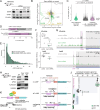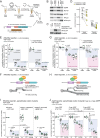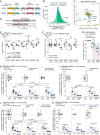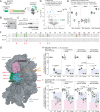MCTS2 and distinct eIF2D roles in uORF-dependent translation regulation revealed by in vitro re-initiation assays
- PMID: 39748120
- PMCID: PMC11790910
- DOI: 10.1038/s44318-024-00347-3
MCTS2 and distinct eIF2D roles in uORF-dependent translation regulation revealed by in vitro re-initiation assays
Abstract
Ribosomes scanning from the mRNA 5' cap to the start codon may initiate at upstream open reading frames (uORFs), decreasing protein biosynthesis. Termination at a uORF can lead to re-initiation, where 40S subunits resume scanning and initiate another translation event downstream. The noncanonical translation factors MCTS1-DENR participate in re-initiation at specific uORFs, but knowledge of other trans-acting factors or uORF features influencing re-initiation is limited. Here, we establish a cell-free re-initiation assay using HeLa lysates to address this question. Comparing in vivo and in vitro re-initiation on uORF-containing reporters, we validate MCTS1-DENR-dependent re-initiation in vitro. Using this system and ribosome profiling in cells, we found that knockdown of the MCTS1-DENR homolog eIF2D causes widespread gene deregulation unrelated to uORF translation, and thus distinct to MCTS1-DENR-dependent re-initiation regulation. Additionally, we identified MCTS2, encoded by an Mcts1 retrogene, as a DENR partner promoting re-initiation in vitro, providing a plausible explanation for clinical differences associated with DENR vs. MCTS1 mutations in humans.
Keywords: DENR-MCTS1; In Vitro Translation; Re-Initiation; eIF2D; uORF.
© 2025. The Author(s).
Conflict of interest statement
Disclosure and competing interests statement. The authors declare no competing interests.
Figures





Similar articles
-
DENR promotes translation reinitiation via ribosome recycling to drive expression of oncogenes including ATF4.Nat Commun. 2020 Sep 16;11(1):4676. doi: 10.1038/s41467-020-18452-2. Nat Commun. 2020. PMID: 32938922 Free PMC article.
-
DENR-MCTS1 heterodimerization and tRNA recruitment are required for translation reinitiation.PLoS Biol. 2018 Jun 11;16(6):e2005160. doi: 10.1371/journal.pbio.2005160. eCollection 2018 Jun. PLoS Biol. 2018. PMID: 29889857 Free PMC article.
-
Tma64/eIF2D, Tma20/MCT-1, and Tma22/DENR Recycle Post-termination 40S Subunits In Vivo.Mol Cell. 2018 Sep 6;71(5):761-774.e5. doi: 10.1016/j.molcel.2018.07.028. Epub 2018 Aug 23. Mol Cell. 2018. PMID: 30146315 Free PMC article.
-
Translational Regulation by Upstream Open Reading Frames and Human Diseases.Adv Exp Med Biol. 2019;1157:99-116. doi: 10.1007/978-3-030-19966-1_5. Adv Exp Med Biol. 2019. PMID: 31342439 Review.
-
Regulation of fungal gene expression via short open reading frames in the mRNA 5'untranslated region.Mol Microbiol. 2003 Aug;49(4):859-67. doi: 10.1046/j.1365-2958.2003.03622.x. Mol Microbiol. 2003. PMID: 12890013 Review.
References
-
- Bohlen J, Fenzl K, Kramer G, Bukau B, Teleman AA (2020a) Selective 40S footprinting reveals cap-tethered ribosome scanning in human cells. Mol cell 79:561–574 - PubMed
MeSH terms
Substances
Grants and funding
LinkOut - more resources
Full Text Sources
Miscellaneous

